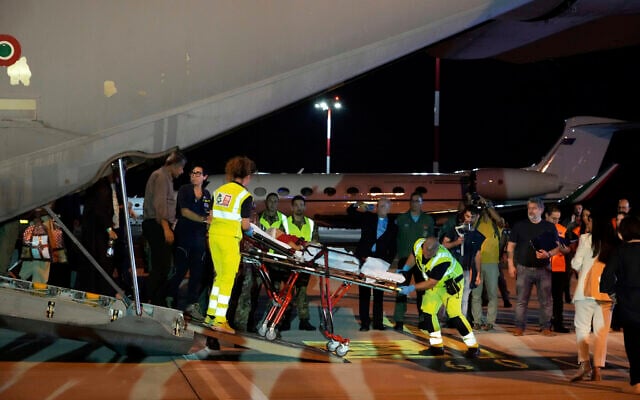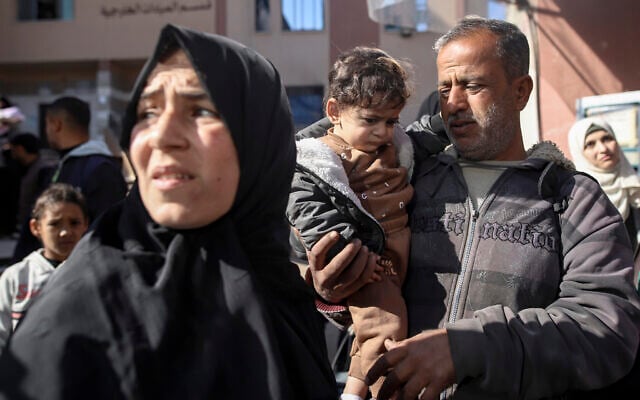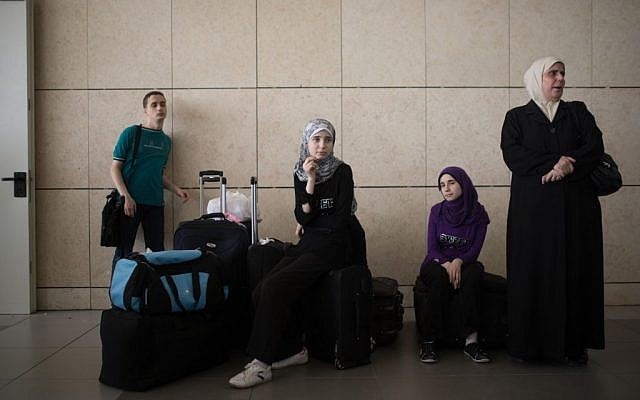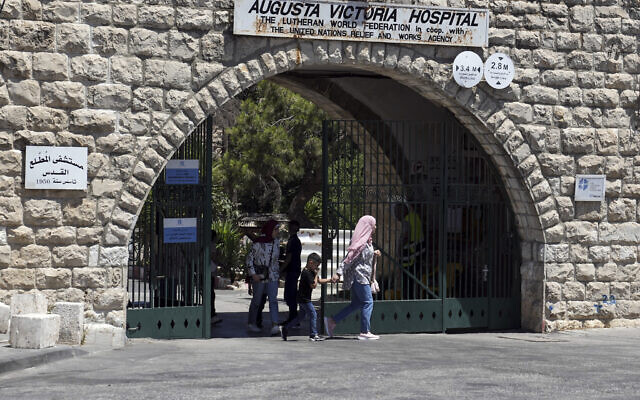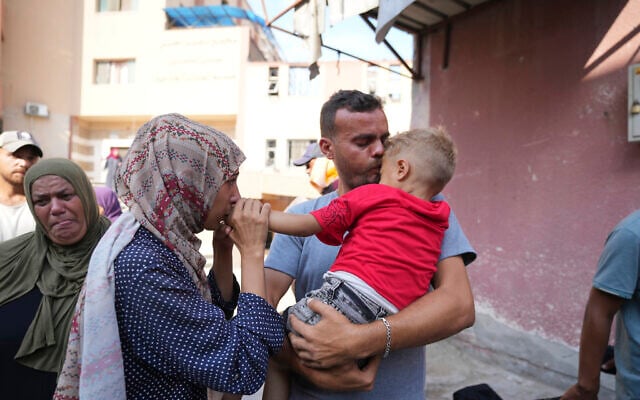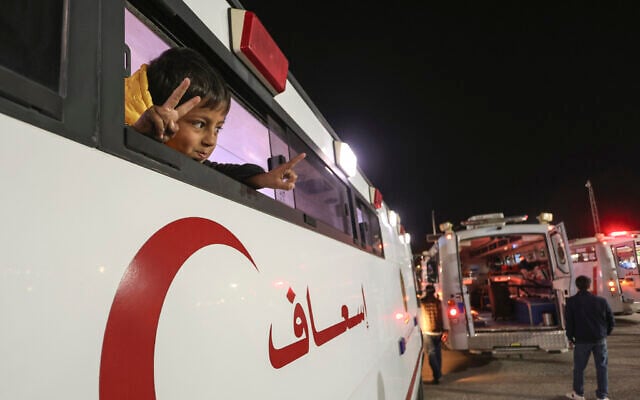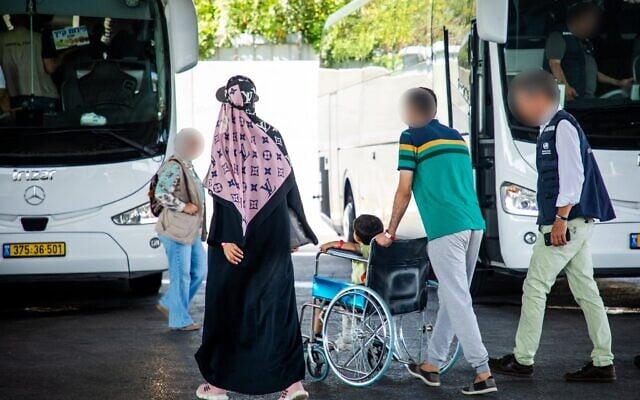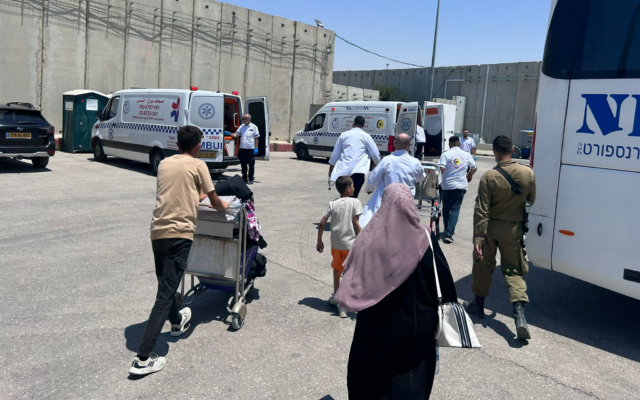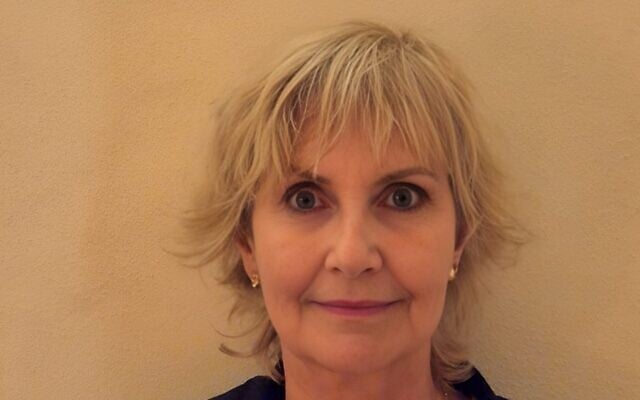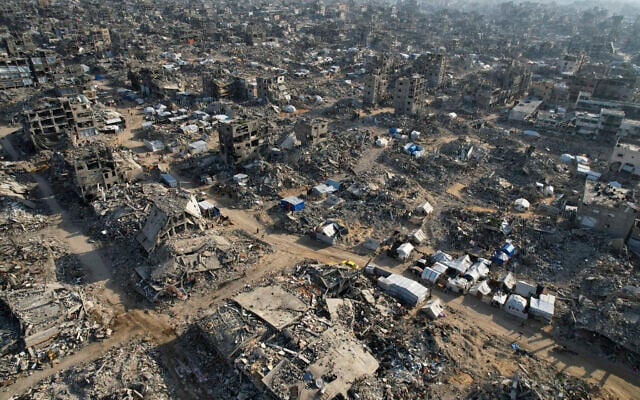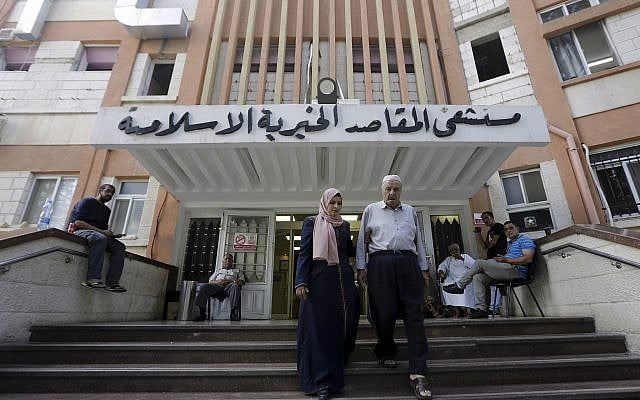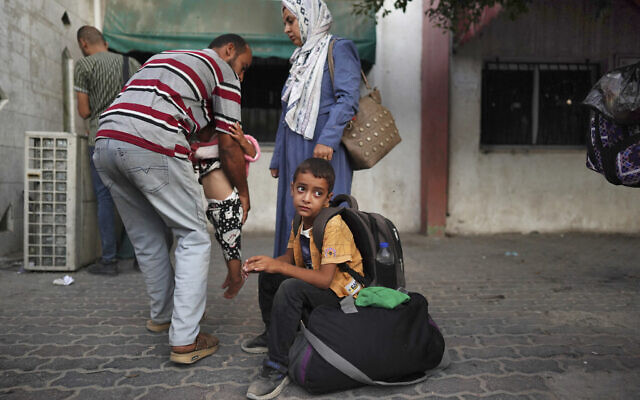



Through the waves of crises to befall Gaza since October 2023, one humanitarian effort has remained relatively steady throughout the war — the evacuation of the sick and war-wounded out of the Strip for medical care. Through ceasefires and periods of intense fighting, Israel has played a role in facilitating the exit of thousands of ill and injured Gazans to Arab countries, Europe and elsewhere, along with family members accompanying them.
Israel has been heavily involved in who leaves Gaza since June 2024, when it started using the Kerem Shalom Crossing to evacuate Palestinians via its own territory, following the closure of the Rafah Border Crossing into Egypt a month earlier. For the first nine months, some 1,500 Gazans were allowed to exit the Strip, about 150 per month, according to Israel’s Defense Ministry body that coordinates with humanitarian operations in Gaza, known as COGAT.
That number has risen significantly since, with some 2,500 leaving Gaza from mid-March to July, representing between 500 and 600 a month, according to COGAT. The numbers include both medical evacuations, those escorting patients and others given permission to leave for various reasons, including foreign citizenship, student visas or other ties abroad.
Israel says most who leave do so to receive treatment or accompany someone sick or wounded, without specifying an exact breakdown.
World Health Organization figures for the same period, however, put the number of actual patients leaving Gaza over that same period at just 399. The figure represents less than 3 percent of the 14,800 patients urgently needing to leave Gaza for treatment, according to a July 31 statement from the organization.
“Any small, short-term increase Israel cites in evacuation numbers — even if true — is a drop in the ocean,” said Shai Greenberg, a spokesperson for the Gisha NGO, which assists Gazans seeking to leave the strip. “Boasting about it is part of Israel’s ongoing effort to mask reality and present a false picture of meeting its obligations.”
According to Ben-Gurion University Prof. Dorit Nitzan, who has assisted evacuating sick and wounded Gazans in an unofficial capacity since the start of the war, Israel has shown more flexibility in approving evacuations in recent months, leading to the increase.
“Since March 2025, Israel’s security apparatus — COGAT, the Shin Bet — has significantly eased the process for patients to travel for treatment outside Gaza,” said Nitzan.
Nitzan spent 20 years of experience coordinating evacuations from disaster zones worldwide during her work with the WHO before returning to her native Israel, where she is today the head of the School of Public Health at Ben-Gurion University.
Every departure from Gaza requires Israeli security clearance, including checks on the person’s identity and whether they are deemed a security risk. “At the start of the war, we saw a very low approval rate; today, most names are approved,” Nitzan said. “Every week there’s at least one evacuation, ranging from dozens to hundreds of people — depending on the receiving countries’ capacity.”
However, organizations helping Gazans leave say they have not noticed a significant change in recent months.
Asil Abu Rass, Head of the Occupied Territories Department at Physicians for Human Rights, told The Times of Israel: “From what I see, there has been no easing. Two-thirds of the patients evacuated during the entire war in Gaza left through Rafah a year and a half ago and not through Israel.”
Greenberg told the Times of Israel that “Israel continues to deny medical care to thousands of other injured and sick people, including many children, by blocking their exit from Gaza to places where they could receive proper treatment.”
The ability of patients, the wounded and their accompanying relatives to leave Gaza during the war has been complex and has shifted depending on the fighting on the ground.
Both Israel and Egypt shut all crossings in and out of the Strip immediately after Hamas’s October 7, 2023, attack, in which thousands of terrorists stormed into southern Israel, killing 1,200 people and taking 251 hostages back into Gaza.
The closures had far-reaching consequences, cutting off permits for Gazans who previously worked in Israel, but the impact on patients was especially severe.
Even before the war, Gaza’s healthcare system was severely underdeveloped compared to Western standards, with limited treatment options, especially for cancer care. As a result, many Gazans traveled to Israel or the West Bank for medical treatment — funded by the Palestinian Authority or, more rarely, by humanitarian organizations — in coordination with Israel through the PA’s Civil Affairs Committee.
This body was responsible for coordinating movement requests between Gaza residents and Israel, and continued operating after Hamas seized control of the Strip in 2007. It has served as the sole intermediary between Gaza’s residents and Israel, which refuses to coordinate with any Hamas-controlled authority in Gaza.
Patients seeking care outside of Gaza would submit requests to the Civil Affairs Committee, including medical documentation and a permit from Gaza’s health ministry. The PA would determine whether to fund the treatment and pass the list of applicants to Israel, which would perform security checks to ensure those requesting to enter the country had no links to armed Palestinian groups.
Thousands were approved, but many requests were turned down by Israel. Of 20,411 applications submitted for patients to leave Gaza for medical care in 2022, some 34% were denied, according to WHO data. Sometimes the denials were explicit, though a reason was not always given, and sometimes Israel simply failed to provide an answer either way before the scheduled appointment time.
Nitzan said dealing with Gazans seeking care in Israel or the West Bank was a regular occurrence in the past.
“Some stayed in Israel for extended periods because of long treatment courses – children after organ transplants, cancer patients, both adults and children,” she said. “These treatments simply didn’t exist in Gaza, so the only option was to send them out for care.”
According to WHO figures provided on August 6, 2025, between 50 and 100 patients left Gaza every day for treatment before the war. Since October 7, that daily average has dropped to 11.
Restrictions on goods entering the Strip and heavy fighting have crippled Gaza’s already fragile health system, leaving it unable to provide services to Gazans. At the same time, Israel has stopped admitting Gazans for treatment in Israel or permitting them to reach hospitals in the West Bank or East Jerusalem, complicating their ability to access treatment.
But many are still able to leave the Strip for neighboring countries.
For the first several months of the war, patients turned to Egypt, leaving Gaza through the Rafah crossing, which was open from November 2023 until May 2024, when Israeli troops took control of the crossing and the Philadelphi Route.
Israel continued to vet patients leaving through Rafah and relatives escorting them, while the WHO stepped in to coordinate between Gaza’s Health Ministry and Israel instead of the PA’s Civil Affairs Commission. From Rafah, the vast majority of patients would receive treatment within Egypt, though some would travel on to third countries.
According to the WHO, from November 2023 to May 2024, when Rafah was open, 4,947 patients transited through Rafah. COGAT put the number at 30,000, including companions and those leaving for reasons other than medical care, and denied Egyptian media reports that the true figure was closer to 100,000.
Following the closure of Rafah, Physicians for Human Rights, Gisha, and HaMoked petitioned Israel’s High Court to allow patient evacuations through Israeli territory instead. The state replied on June 30, 2024, that a mechanism was being developed and that individual approvals had already been granted – including for 19 sick children and 49 companions – leading to the petition’s dismissal. The new process involved physically transferring patients through Israel and seeking third countries willing to host and fund treatment and accommodation.
Since then, Israel says it has allowed thousands of patients and those accompanying them to exit via the Kerem Shalom Crossing, traveling to the West Bank’s Allenby Bridge Crossing into Jordan and receiving treatment there or flying to further destinations that agreed to take them in and treat them.
In February 2025, Israel also began allowing them to leave via direct charter flights from Ramon Airport in the Negev.
Nitzan said the switch from Rafah to Kerem Shalom as the main transfer point significantly increased Israel’s role in the process.
According to Abu Rass, the move meant that far fewer patients and their companions were given the go-ahead to leave Gaza. From May to December 2024, many patients she tried to assist were denied exit, the Physicians for Human Rights official said.
“If someone was suspected of being in Hamas — even if the link was as distant as a relative’s relative — the entire extended family could be barred from leaving, even if the family tie was as remote as a grandfather’s brother,” she recalled.
Exits appeared to ramp up during a two-month ceasefire in January and February 2025, as Rafah was reopened. According to figures provided by COGAT and WHO, 1,673 patients and over 2,600 escorting relatives exited via Rafah during the truce, including some 600 children.
Nitzan noted that Israel had a unique responsibility to ensure Gazans are able to receive medical care despite its belligerent relationship.
“If Gaza were recognized as a state and declared an enemy state, we’d have no obligation beyond the laws of war,” she said, noting that Russia had no part in WHO missions to evacuate the sick and wounded from Ukraine. “Here it’s different. The side that was attacked on October 7 and now at war with Hamas is also the one required to carry out the evacuations. We are part of this process — we are maintaining human dignity.”
According to a February 2025 position paper by Physicians for Human Rights, between October 2023 and February 2025, 15,600 medical evacuation requests were submitted via WHO, but only 34% — about 5,325 patients — resulted in actual transfers.
The low figure reflects not only Israeli approval rates but also the challenge of finding countries willing to accept patients and their companions as well as fund treatment.
Countries that agree to receive patients and their companions must cover hospital costs and, in the case of children, enroll them in the local education system.
“A country isn’t just taking in the patient – it’s also taking in siblings or parents, funding their stay, and integrating them into schools. It’s not simple,” Nitzan said.
With Israel refusing to allow anyone to enter Gaza, including Palestinians who left the territory for treatment, those stays are currently indefinite, putting many into a seemingly inexorable limbo. Decisions about how long stays are funded or whether family members can seek employment are subject to individual countries’ immigration laws.
Nitzan recalled the case of a liver transplant recipient who left Gaza during the first year of the war. “[She] is still in the Rafah area on the Egyptian side,” the professor said.
According to WHO, Egypt has received the most patients to date – 3,995 – followed by the United Arab Emirates with 1,387, Qatar with 970 and Turkey, which has taken in 437 patients.
COGAT did not respond to a request for comment on whether diplomatic ties with Israel play a role in where patients who transit through Kerem Shalom are sent.
Other countries that have taken patients include the United States, Jordan, France, Italy, Spain, Germany, Romania, the United Kingdom, the Netherlands and Norway.
Nitzan identified the need to find third countries as a major bottleneck in the process of securing treatment for sick or wounded Gazans.
Advocates say the best course of action would be to reinstate access to hospitals in the West Bank or East Jerusalem.
“There are Palestinian hospitals ready to receive them — like Augusta Victoria in East Jerusalem, which before the war reserved 30% of its beds for Gazan patients and works closely with hospitals in Gaza. Hospitals in Nablus and Jenin are also ready,” Abu Rass said.
“Israel’s insistence on sending patients abroad instead is stalling the process. West Bank and East Jerusalem hospitals could also stabilize more severe cases before transferring them abroad,” she added.
Greenberg, from Gisha, called on Israel to “allow permanent, transparent, consistent, swift, and efficient evacuations, including to West Bank and East Jerusalem hospitals, without separating children from their parents and guarantee their right to return.”
The process of securing medical evacuations from Gaza during the war has become even more complex than it was before October 7, though it was never quite simple.
“You need a doctor’s referral stating you require treatment outside Gaza — and that’s not always available in Gaza,” Abu Rass said. “The patient submits this documentation through… a local hospital to a committee in the Gaza health ministry. It’s not enough for a doctor to give an opinion; the committee reviews and prioritizes who most urgently needs to leave. That committee has been operating throughout the war, just as it did before, but now the list goes to WHO instead of the Civil Affairs Committee.”
In response to The Times of Israel, WHO said it “works with the Israeli authorities to secure approvals for evacuees and their companions once the final approved lists from the Gaza health ministry are received.”
Nitzan noted that for some patients, reaching a doctor to obtain the referral is itself a challenge: “If there’s a very sick child whose parents are constantly moving due to the fighting, I don’t know if everyone knows how to get onto the list — you need to know whom to approach. With limited access to international organizations and few personnel on the ground, getting the right person onto the list is a challenge.”
This is not unique to Gaza, she added: “In every emergency zone, the challenge is how to get the person at the far end onto the list.”
Once WHO receives the lists, they are passed to Israel for a security screening and a search begins for a potential host country. This outreach is conducted by multiple actors — WHO, Israel and humanitarian groups — each using their own networks to secure treatment offers abroad. As a result, the process does not always follow a neat, step-by-step sequence.
Abu Rass said that sometimes WHO first secures an agreement from a receiving country before sending names for Israeli security checks: “With so many requests and people needing to leave, they only send for approval those who have a realistic chance of exiting,” she said.
Alongside the patient’s name, the list also includes companions essential for support, especially for small children.
Some countries only accept certain types of patients, Abu Rass noted.
“Many refuse to take adults and accept only children — Italy, for example,” she said. “The UAE has declined to receive war-wounded, accepting only the sick. Jordan agreed to take only children with cancer. Each country has its own criteria.”
While most patients go through the Gaza health ministry, WHO and some host countries have at times also submitted names independently, bypassing the Hamas-controlled authority.
“States like the UAE can identify patients they wish to receive, add their names to the list and send them to Israel for approval,” Nitzan said.
Abu Rass told The Times of Israel that the UAE has, at times, sent lists of patients’ names directly to Israel without WHO involvement, requiring only security clearance.
Once a case has been cleared medically, approved by Israel’s security authorities, and accepted by a receiving country, WHO representatives in Gaza contact the family and organize the evacuation.
Most evacuees are women and children. According to COGAT, about 80% of those evacuated during the war have been children.
Nitzan said this reflects not only the preferences of receiving countries, but also the reality of Israeli security vetting.
“Anyone linked to fighters or armed factions in Gaza will not pass,” she said. “Women and children are easier to approve, and humanitarian organizations always prioritize them as a population to be removed from conflict zones.”
The process can take considerable time. Nitzan said though Israel had eased its own approval process, there was still a serious bottleneck in finding countries willing to host patients or fund treatment.
WHO told The Times of Israel that some patients in Gaza have been waiting more than 18 months for evacuation. The organization did not specify whether the delays were due to logistical challenges, Israeli refusals, or the lack of a willing host country.
Today, Aisha is in Norway, but getting there from Gaza took some 20 months of red tape and waiting for various approvals, her sister-in-law Najm told the Times of Israel.
The 35-year-old from Beit Lahiya in northern Gaza has suffered from a severe degenerative disease from an early age, leaving her in constant pain and struggling to walk. For the last 15 years, she has relied on Najm as her primary caregiver, bringing her with her to Scandinavia when she was finally able to leave the Strip late last month.
“She has been sick for 30 years, and the treatment for her disease doesn’t exist in Gaza. From the day I got married, I’ve been helping her — dressing her, caring for her,” said Najm, also 35, who spoke for Aisha due to difficulties speaking stemming from her condition.
Both women asked to remain anonymous for privacy reasons. (Aisha and Najm are pseudonyms).
Najm said that Aisha used to travel to Tel Hashomer hospital near Tel Aviv for treatment, but later started going to Palestinian hospitals instead. The last time Aisha left Gaza for medical care was eight years ago, when she was treated at Al-Makassed Hospital in East Jerusalem.
The family applied for Aisha’s evacuation in November 2023, just weeks after the war began, as conditions became extremely difficult. Less than a week after October 7, the family fled their home near Gaza’s border with Israel, which was later blown up in an Israeli strike.
“From that day until we left Gaza, we kept moving from place to place. We were displaced,” Najm recalled.
To get approval to leave, they submitted a form to the Gaza health ministry, which was approved and sent to the WHO. But it was still a year and eight months before they were able to leave.
“The process took a very long time,” Najm said.
As the war ground on, Aisha’s supply of pain-relief medication ran out. “The wait was very hard — Aisha was in terrible pain, surviving on painkillers,” Najm said. “[The extended family] were also waiting for a chance to escape death in Gaza — any way to get out of death, hunger, and oppression for us and the children.”
The NGO Gisha, which helped coordinate their departure, told The Times of Israel that a hospital in Belgium had agreed to receive Aisha as early as March 2025. But despite repeated WHO requests to arrange the evacuation, there was no response from the Israeli side.
Only after Gisha contacted COGAT directly in late June did they receive confirmation that “there is no objection to allowing their exit.”
A month later, on July 30, Aisha, Najm and Najm’s five children finally left Gaza — though not to Belgium. For reasons that remain unclear, they were accepted instead by a hospital in Norway.
The journey out had its own series of twists and turns. “On the day we left Gaza, we traveled from where we were staying in Gaza City to Shifa Hospital. From Shifa, they took us to the Red Crescent headquarters in Khan Younis, where we stayed overnight. The next morning, Wednesday, we went to the Kerem Shalom Crossing, then traveled through the desert to Ramon Airport — a four-and-a-half-hour drive. From there we flew to Romania and then on to Norway,” she said.
“We took nothing but documents — ID papers, medical records and a phone. We weren’t allowed to take anything else — not even clothes,” Najm noted.
Also left behind was Najm’s husband, whom Israel refused to let out, despite having a US student visa.
“He’s in Gaza City now. I hope he can leave,” she said, before adding, “My heart is always in Gaza.”
COGAT did not respond to The Times of Israel’s questions on the case.
Najm said she doesn’t know what the future holds for her, Aisha, or the children, but she doubts she will return to Gaza.
“Right now, we’re helping Aisha, but if my husband arrives [in Norway], we’ll think about what to do. Gaza is no longer livable,” she said. “I don’t want to make such a family decision alone. If my husband comes here — or if we meet somewhere outside Gaza — we’ll decide together whether to choose one place to live or stay here. Gaza has been destroyed completely.”

